

Fact-checking hoaxes and conspiracies about the coronavirus. Falsehoods about a new strain of the coronavirus spreading from China vary widely, from Facebook posts that take a patent out of context to conspiracy theories about Bill Gates.
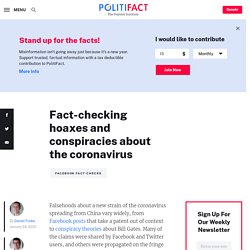
Many of the claims were shared by Facebook and Twitter users, and others were propagated on the fringe internet and notorious conspiracy websites. One falsehood was even shared by a 2020 U.S. Senate candidate. The virus has infected more than 900 people worldwide, and China has restricted travel within the country amid a rising death toll. Misinformation about the coronavirus has particularly taken root in Facebook groups for anti-vaccine advocates and believers in QAnon, a broad, right-wing conspiracy theory. How One Particular Coronavirus Myth Went Viral. Study investigates if COVID-19 came to Calif. in fall 2019 - SFGate. This test tube contains a blood sample from a patient who tested positive for the COVID-19 coronavirus in this March 20 file photo.
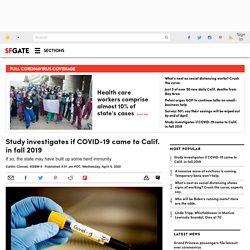
A new Stanford Medicine study is using blood tests to try to determine if Californians were exposed to the novel coronavirus as early as last fall. lessThis test tube contains a blood sample from a patient who tested positive for the COVID-19 coronavirus in this March 20 file photo. A new Stanford Medicine study is using blood tests to try to determine if ... more Photo: CBSI/CNET This test tube contains a blood sample from a patient who tested positive for the COVID-19 coronavirus in this March 20 file photo.
A new Stanford Medicine study is using blood tests to try to determine if Californians were exposed to the novel coronavirus as early as last fall. less. Factitious. Sifting Through the Pandemic – Information hygiene for the Covid-19 infodemic. Just add Wikipedia – Sifting Through the Pandemic. Summary Most major English-language publications have Wikipedia page.If you don’t recognize a source, search the url + ” wikipedia” to find the relevant Wikipedia page.Scan the page asking:Is this source what I thought it was?
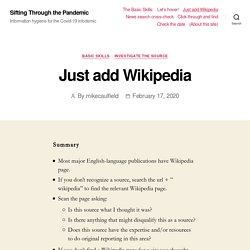
Media Bias/Fact Check - Search and Learn the Bias of News Media. Deepfake AI Technology Risks, Dangers. Imagine this: You click on a news clip and see the President of the United States at a press conference with a foreign leader.

The dialogue is real. The news conference is real. You share with a friend. They share with a friend. Soon, everyone has seen it. Sound farfetched? In the clip, comedian Bill Hader shares a story about his encounters with Tom Cruise and Seth Rogen. What Is a Deepfake? The Hader video is an expertly crafted deepfake, a technology invented in 2014 by Ian Goodfellow, a Ph.D. student who now works at Apple. GANs enable algorithms to move beyond classifying data into generating or creating images. Do Motorists Now Face $999 Fines and 3-Year Suspensions for Using Cellphones While Driving? A viral message on Facebook claimed that motorists caught using (or even holding) their cell phones while driving would be fined $999 and face 3-year license suspensions due to a new law implemented at the start of 2019: This message was lacking some important details, such as where this law was supposedly implemented.

Although a number of states and countries have started cracking down on distracted driving through the passage of related laws, they do not all specify the same punitive measures for violations of those laws. This Facebook post appears to be referencing the new distracted driving laws implemented in Ontario, Canada, at the start of 2019, but message still managed to fudge a few details of that law. Search Snopes.com. Fake News - Social Media - Research Guides at Dickinson College. Fake News and Cyber Propaganda: The Use and Abuse of Social Media - Beveiliging Nieuws - Trend Micro NL. View Fake News and Cyber Propaganda: The Use and Abuse of Social Media When the term “fake news” comes up, people usually think of social media posts with rather fantastic, implausible stories.
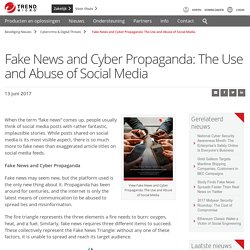
Is 'fake news' fooling kids? The answer is yes. Although 44% of tweens and teens in a recent survey said they can tell the difference between fake news stories and real ones, more than 30% who said they shared a news story online during the past six months admitted that they didn't get it exactly right.
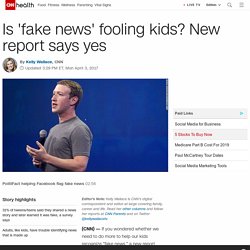
They said they later found out that a story they shared was wrong or inaccurate, according to the survey by Common Sense Media, a nonprofit organization focused on helping parents, kids and educators negotiate media and technology. The survey of 853 children ages 10 to 18 in the United States also asked kids how much they trust the information they received from each of their news sources.
Family got higher marks than teachers, news organizations and friends. Sixty-six percent of tweens and teens said they trust the information they received from family, compared with 48% for teachers and other adults, 25% for news organizations and just 17% for friends. How to Spot Real and Fake News. © GettyImagesclu Developing a critical mindset is the first step to spotting fake news.
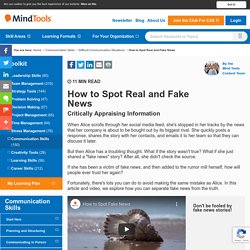
When Alice scrolls through her social media feed, she's stopped in her tracks by the news that her company is about to be bought out by its biggest rival. A Reminder That 'Fake News' Is An Information Literacy Problem - Not A Technology Problem. Getty Images.
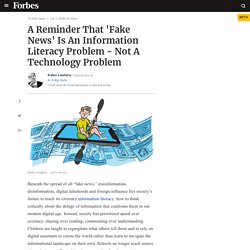
Beneath the spread of all “fake news,” misinformation, disinformation, digital falsehoods and foreign influence lies society’s failure to teach its citizenry information literacy: how to think critically about the deluge of information that confronts them in our modern digital age. Instead, society has prioritized speed over accuracy, sharing over reading, commenting over understanding. Children are taught to regurgitate what others tell them and to rely on digital assistants to curate the world rather than learn to navigate the informational landscape on their own. Schools no longer teach source triangulation, conflict arbitration, separating fact from opinion, citation chaining, conducting research or even the basic concept of verification and validation. It is the accepted truth of Silicon Valley that every problem has a technological solution. Sadly for the Valley’s technological determinists, this is far from the truth. Getty Images. Deep Fakes And Fake News Exist Because Today We Believe Everything We Read On The Internet.
What happened to that quaint era once upon a time when society was taught not to believe everything it read on the Internet?
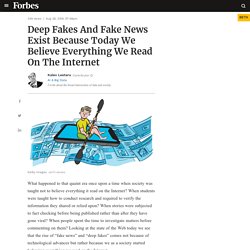
When students were taught how to conduct research and required to verify the information they shared or relied upon? When stories were subjected to fact checking before being published rather than after they have gone viral? When people spent the time to investigate matters before commenting on them? Looking at the state of the Web today we see that the rise of “fake news” and “deep fakes” comes not because of technological advances but rather because we as a society started believing everything we read on the Internet. Over its brief quarter century of existence, the Web has upended much of the informational norms and societal standards that once governed the informational commons. How to Fight ‘Fake News’ (Warning: It Isn’t Easy) No, the Reese’s Peanut Butter Cup is not being discontinued.
No, Earth will not be plunged into darkness for 15 days. And, no, Katy Perry did not broker peace with the Islamic State. Those are a few of the falsehoods spread online that are in need of debunking in this age of “fake news,” when misinformation seems to appear from nothing and reaches hurricane-force speeds in an instant. Researchers have spent decades trying to understand how such misinformation spreads and, now, a review of their work offers new guidance for the journalists, fact-checkers and others working to find, and defend, the truth. In a report published last week in Psychological Science, a team of academics reviewed two decades of research to better understand how to effectively debunk misinformation. Based on the findings of those experiments, the authors offer these broad recommendations for how to expose misinformation. With no alternative to replace it, the discredited theory proves remarkably resilient.
Thedcgazette.com - Fake news sites to watch out for - Pictures. Social Media and Filter Bubbles. Fake or real middleschool 8. Researchers find students have trouble judging the credibility of information online. When it comes to evaluating information that flows across social channels or pops up in a Google search, young and otherwise digital-savvy students can easily be duped, finds a new report from researchers at Stanford Graduate School of Education. The report, released this week by the Stanford History Education Group (SHEG), shows a dismaying inability by students to reason about information they see on the Internet, the authors said.
Students, for example, had a hard time distinguishing advertisements from news articles or identifying where information came from. "Many people assume that because young people are fluent in social media they are equally perceptive about what they find there," said Professor Sam Wineburg, the lead author of the report and founder of SHEG. Is 'fake news' fooling kids? The answer is yes.